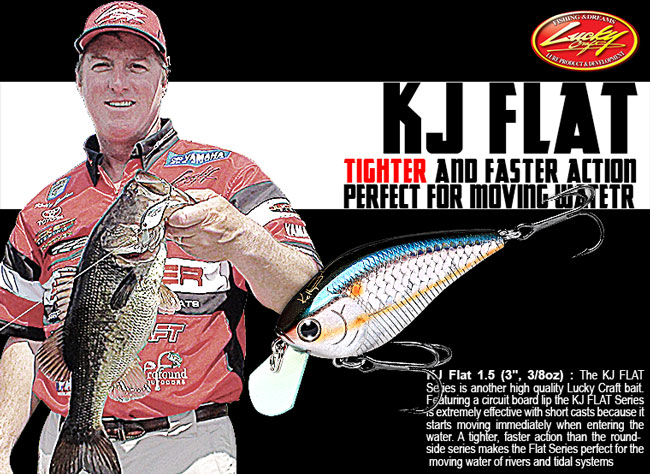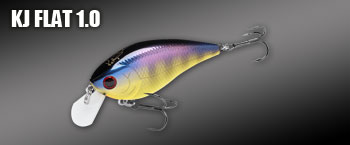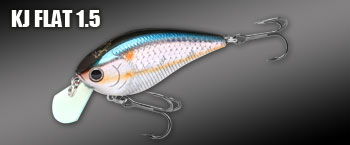 |
 |
 |
| KJ FLAT 1.0 / 2-1/4"(57mm) / 1/4 oz(7.2g) / Floating | KJ FLAT 1.5 / 2-1/2"(65mm) / 3/8 oz(10.0g) / Floating |
 |
 |
 |
| KJ FLAT 1.0 / 2-1/4"(57mm) / 1/4 oz(7.2g) / Floating | KJ FLAT 1.5 / 2-1/2"(65mm) / 3/8 oz(10.0g) / Floating |
Kelly Jordon Flattens the Cranking Competition
Veteran Texas pro, Kelly Jordon, is gradually enlarging his crankbait “garage.” Like most pros, he’s used square bills such as the Lucky Craft LC and SKT Series as the workhorses on tour for many years, but as fisheries get tougher and pressure increases, he frequently finds himself reaching for something a little bit more subtle and sporty: the flat-sided Lucky Craft KJ Flat.
“If the square bill is a pickup truck, then the flat side is more like a Ferrari,” he explained.
Increasingly, he finds himself getting behind the wheel of this sleeker version.
“It’s a very close brother to a square bill,” he explained. “You fish it in the same type of water, at approximately the same depth. It’s not as much of a brush buster because it doesn’t deflect off of wood like laydowns and stumps, but it shines in cold water, post-frontal conditions and pressured situations.”
Often, he’ll use the more aggressive square bill to locate fish in practice and then the KJ Flat to eke out every last bite possible. In last year’s Elite Series tournament at Bull Shoals, he was running the backs of creeks, but the one he felt gave him the best chance to place high in the event was jammed with other competitors. The fish had seen just about every square bill in the Bass Pro Shops catalog, but when Jordon brought out the tighter-wobbling bait, it was game on. “I found them with a square bill, but I wore them out on the KJ Flat,” he said. “At one point, I must’ve caught 25 in a row. If you got it in front of them, it was just stupid how good it was. Many times in shallow situations, after you think you’ve worn out a place, this lure will continue catching them way better than anything else.”
The KJ Flat isn’t quite as easy to throw as its square-billed brethren, but at 3/8 of an ounce, it doesn’t require spinning tackle, which is a substantial advantage, particularly in big fish country. Unlike some other flat-sided baits, which not only throw like a potato chip, but also provide just a “damp” feeling through the rod, the KJ Flat telegraphs its activities from the start of the retrieve until you’re ready to make the next cast.
“It’s not quite as wide of a vibration as a square bill,” Jordon said. “It’s a quicker, tighter wobble, but you can definitely feel it coming through cover, whether you’re ticking the top of the grass or bringing it over a gravel bank. It also pauses really well. It’s buoyant, but not super, super buoyant, so there are lots of different ways to retrieve it – you can burn it, slow roll it, or ‘stop and go’ it. It also has a lot of action going really slow, which is particularly good when the water is cold or any other time you need to keep it in a particular area longer.”
While Jordon is particularly fond of his namesake flat-side when it’s cold, he doesn’t put it away for the year when the bass head to the beds. He said the lure’s exceptionally lifelike water displacement profile makes it a perfect choice during the shad spawn, which often extends until the water is in the mid-70s. It’s also on the deck of his boat in the late summer and well into the fall whenever he thinks there’s a chance he’ll encounter schooling fish… where the body shape and Lucky Craft’s exceptional finishes make it an awesome tool for feeding bass that often prove to be surprisingly finicky.
Like all Lucky Craft crankbaits, the lure was exhaustively tested before it was put on the market, and it comes in a wide array of color patterns that mimic a range of forage. For those perplexed by the multitude of options, Jordon said it pays to keep things simple.
“You always want to have something with a white base,” he said. “My favorites are Chartreuse Shad and Gunmetal Shad. In fact, Gunmetal Shad is probably my number one choice. Then, you have to have something red, like TO Craw. While the lure’s profile resembles a shad, it does kick out like a crawfish, too, so if that’s what fish are feeding on, we have you covered. And then you have your chartreuses – of course Chartreuse with a Black Back is the standard, but my other favorite is a color Skeet came up with called Crack.”
Jordon said he sees anglers who are afraid to throw crankbaits in clear water, but once again this is where Lucky Craft’s attention to detail pays off. With a wide range of chrome patterns, as well as translucent colors like Ghost Minnow, you can power fish without overwhelming your clear water prey.
“Those translucent colors are almost clear,” he said. “So when it’s a time of year when the bait is really small, you can almost match the hatch. Something like Ghost Minnow looks smaller than it is, instead of something big and shiny, and in pressured waters a more natural color can make a big difference.”
The nearly 8-foot long “launcher”-style rods typically used with big, deep-diving crankbait are overkill with this lure, but Jordon noted that each angler has to make certain compromises to find exactly the right rod: “It’s a trade-off. When you’re making short casts in tight cover, a lot of times a shorter rod is more accurate but there will be other times you want to cast it as far as you can. A happy medium seems to be a 7-foot rod, or maybe even a 6 and a half footer.” He’s settled on a Duckett Micro Magic 7-foot medium action cranking rod and pairs it with a prototype Duckett cranking reel. Is he an adherent of the belief that it’s necessary to use a slow gear ratio to ensure a leisurely retrieve and to maximize cranking power? “I never go below 6:1,” he replied. “Usually 6.3:1 or 7:1 is perfect. You can slow it down really easy and still feel it throbbing, and if you have to speed it up, you can. If you get worn out throwing one of these small crankbaits, you don’t need to go to a slower reel, you need to start working out.” He never goes below 12 lb. test fluorocarbon for this application, and will often increase his line a size or two on big fish, heavy cover fisheries like his home lake, Lake Fork.
He said the biggest mistake most anglers make with this lure is either not to own them, or to let them sit in the tackle box far too much.
“A lot of people don’t throw them,” he said. “At this point, square bills are so popular that everybody has a 1.5-something, copied from the Lucky Craft, which caused the square bill craze. But this is something the fish haven’t seen a whole lot, and when things get tough that can make a big difference. Everybody has their pets. It’s not going to replace the square bill, but it’s another club in the bag.”